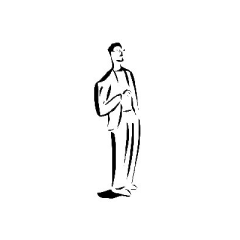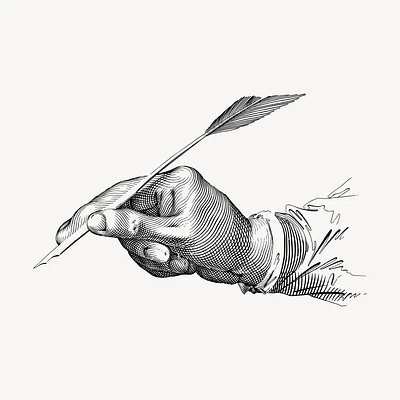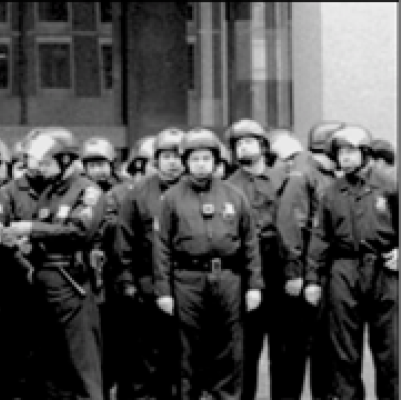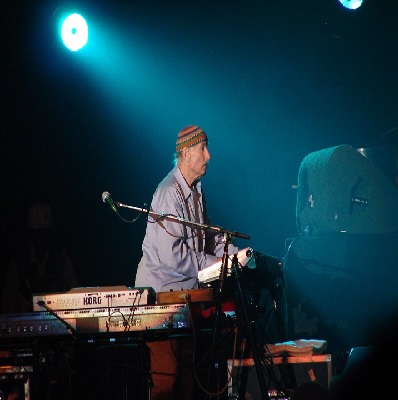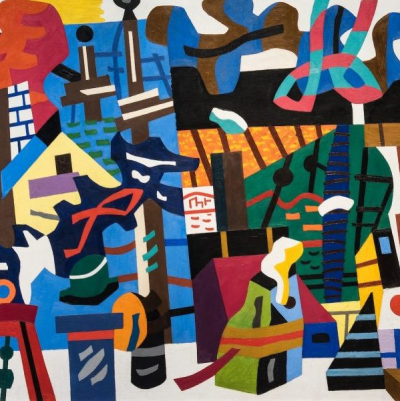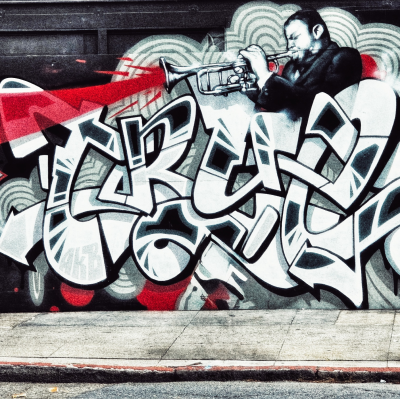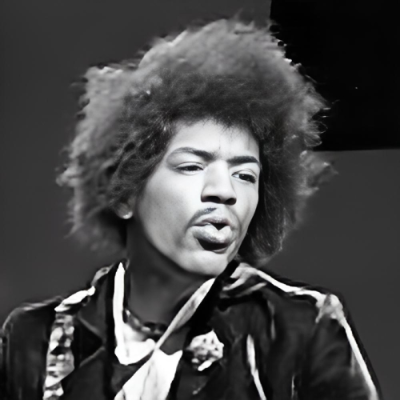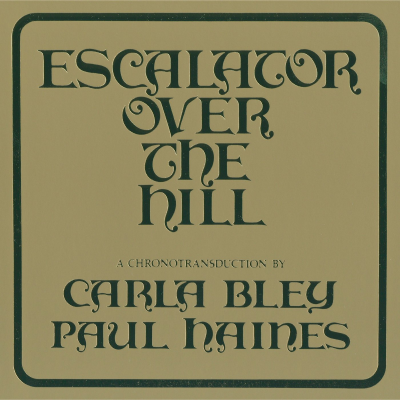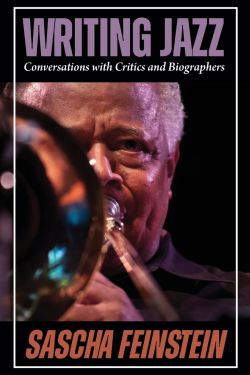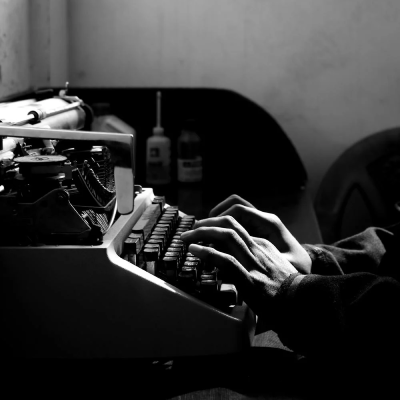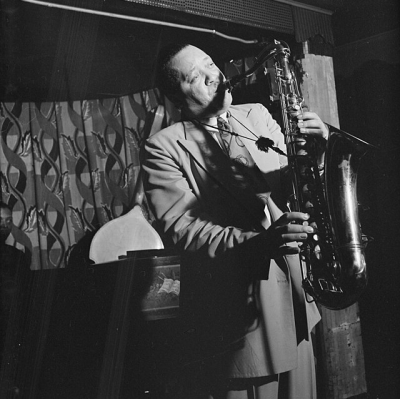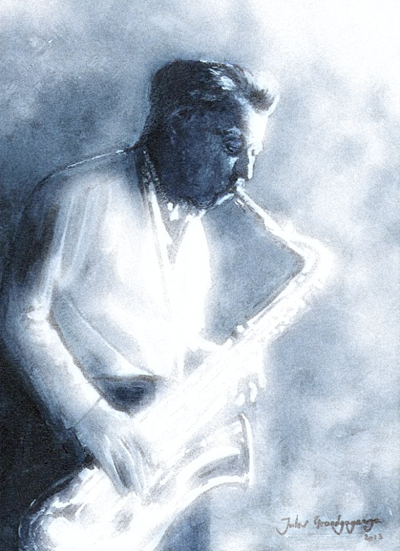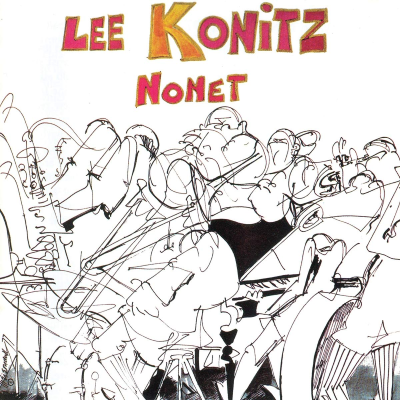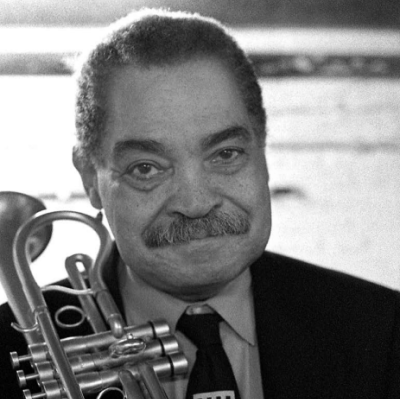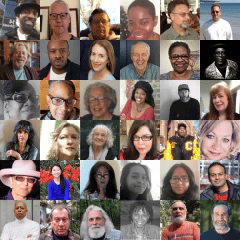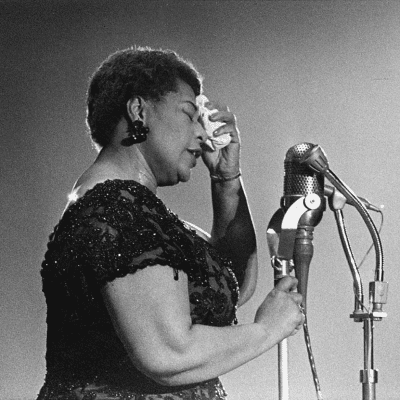.
.
.
.
For over twenty years, publishing quality jazz-themed fiction has been a mission of Jerry Jazz Musician. Hundreds of short stories have appeared on the pages of this website, most all of which can be accessed by clicking here.
A substantial number of novels and stories with jazz music as a component of the story have been published over the years, and the scholar David J. Rife has written short essay/reviews of them, which he has compiled in two valuable resources, Jazz Fiction: A History and Comprehensive Reader’s Guide (2008), and a recently published sequel, Jazz Fiction: Take Two. (Several of the stories published on Jerry Jazz Musician are reviewed).
Rife’s work is impressive and worth sharing with Jerry Jazz Musician readers. With his cooperation, essay/review excerpts from Take Two will be published on a regular basis.
.
In this edition, Rife writes about stories whose theme is World War II and jazz
.
.
___
.
.
.
…..Jazz Fiction: Take Two is the sequel to Jazz Fiction: A History and Comprehensive Reader’s Guide (2008). The earlier work filled a pressing need in jazz studies by identifying and discussing 700 works of fiction with a jazz component.
…..This work picks up where that one left off, around the turn of the 21st century, and surveys over 500 works of jazz-inflected fiction that have appeared since. None of these works, to my knowledge, have been discussed in this context.
…..The essay-reviews at the center of the book are designed to give readers a sense of the plots of the works in question and to characterize their debt to jazz. The entries were written with both the general reader and the scholar in mind and are intended to entertain as well as inform. This alone should qualify Jazz Fiction: Take Two as an unusual and useful reference resource.
.
-David J. Rife
.
.
___
.
.
photo via Friends of the National World War II Memorial

Major Glenn Miller directs his Army Air Force Band in a performance for U.S. and Allied troops in England, Jun-Dec 1944.
.
___
.
World War II and Jazz
….. It’s not exactly bringing the news to say that World War II changed everything. In jazz, females and people of color became prominent; “All-Girl” bands formed; danceable swing morphed into listenable bebop; large orchestras shrunk to small groups and dance halls tapered into night clubs. Hip was cool. N. R. de Mexico effectively dramatizes the early post-war jazz scene in his pulp novel Marijuana Girl. Other works suggest that the music surrounding the war ethos aided the development of science, contributed to a more diverse society, enabled bi-racial relationships, and in one instance even evolved into the creation of a woman warrior: Pearl, the young female saxophonist in Love in the Years of Lunacy, improbably becomes a foot soldier in the jungles of New Guinea, exchanging fire with Japanese soldiers. And what of the jazz musicians of that era who found themselves in a foreign situation where their music was forbidden? Everyone, but especially Blacks and Jews, scrambled as best they could away from the Nazis and toward freedom. The works below epitomize some of these themes.
.
.
___
.
..
…..This is the most unusual story in the collection for its subject matter: an all-woman jazz band. It’s set mostly in Harlem during WWII when so many men were otherwise occupied, making space for “girl bands.” The story highlights the interactions among the young women in one such band, The Darlings, as they learn the ropes of their collective activity: how to get along in close quarters with strong-willed peers; how to blend their talents with the group; and—a crucial detail—how pigmentation influences the hierarchy of their group. But despite these and such other challenges as long bus rides into the Deep South, these gals take their music seriously—and could they ever wail! Witness this cutting contest between The Darlings and their main competition, The Sweethearts of Rhythm:
.
…..The emcee called for One O’Clock Jump and the audience came out of their seats as both bands jumped into the chorus without any intro. Vi and Mags stepped out to center stage for what everyone was waiting to hear. They started slow and polite with small talk to feel one another out. That got old fast and Vi started jerking her shoulders back and forth barking out notes to hear what Mags would do.
…..Except for moving her fingers up and down the keys of her sax, Mags was very still and blew it back to Vi in a tone of voice sliding through butter. They dug in their heels and traded solos. Vi reached down low in her throat and brought up a shout from the raunchiest part of the gutbucket. That just about stopped everybody’s breath, as we waited to hear what Mags had for an answer. But instead of following her down into the gutbucket, Mags took One O’Clock Jump up into an easy-going long-winded stretch that blew it around the Apollo like a tumbleweed until it came apart, leaving nothing but the air we were breathing. [Whew! Wish I’d been there.]
…..As a result of this spirited performance, the Darlings are invited to perform at Chicago’s famous Grand Terrace Ballroom on the same bill as Billie Holiday. When they meet the great Lady Day, she comes off as a most unladylike Lady but also a compassionate person and consummate artist who allows Flo, the 18-year-old protagonist, to accompany—and improvise with—her, allowing Flo to advance another step on the road to maturity. In important ways this story resembles a female version of Rudolph Fisher’s classic “Common Meter” (1930).
.
.
_____
.
.
…..Short-listed for the Man Booker Prize and winner of the Scotiabank Giller Prize, this nonlinear novel shuttles from Nazi-occupied Germany and Paris to modern-day Baltimore and rural Poland. Its octogenarian narrator, Sid, tells the tense, complicated story of a group of marginalized musicians trying to scratch out an existence in Europe during the tumultuous period leading up to the Second World War. After achieving popularity in Berlin, the Hot Time Swingers are forbidden by the Nazis to play their music, and so at great risk and through the encouragement of Louis Armstrong, they make their way to Paris, reluctantly leaving behind their Jewish pianist who—of course—has been denied papers. (Three of the principals in the novel are half-breeds—Mischlings—and one is a Jew, underscoring the tension in a time of “racial purity.”)
…..Armstrong had urged the group to recongregate in Paris because of their prodigiously gifted trumpeter Hieronymous Falk. Tension becomes palpable as the band attempts to produce a perfect jazz recording of a popular Nazi-resistance song. Before they can put their plan to work, Falk is incarcerated and the other band members run for their lives. Nobody knew that Sid had saved and secreted the last take of “Half-Blood Blues,” causing the record to become so legendary that a documentary film is made of Falk’s life. This happens 50 years after the fact; now, in 1992, Sid and his fellow Baltimorean bandmate, Chip, are invited to return to Berlin for the opening of the film celebrating Falk. After they get there, we learn that earlier events had not been at all as they seemed; in fact, since Sid is likely an unreliable storyteller, we’re left with questions that the book doesn’t allow us to answer. This novel employs (and occasionally overuses) jazz vernacular, depicts musicians at work under extremely trying conditions, and provides a satisfying (but unfortunately truncated) portrait of Armstrong. Here is Sid upon seeing the great jazzman for the first time:
…..A man ain’t never seen greatness till he set his eyes on the likes of Armstrong. That the truth. Those hooded lids, that blinding smile: the jack was immense, majestic. But something else, too: he looked brutally human, like he known suffering on its own terms. His mouth was shocking. He done wrecked his chops from the pressure of hitting them high notes over the years. His bottom lip hung slightly open, like a drawer of red velvets. He lift a handkerchief to his mouth, wipe off a line of spittle. I seen something in him then: a sort of devastated patience, a awful tiredness. I known that look. My mama had it all her life.
…..In its dramatization of jazz artists in Nazi Germany at the outbreak of WWII, this novel joins John A. Williams’ Clifford’s Blues (Minneapolis: Coffee House, 1998) and Tomas Böhm’s The Vienna Jazz Trio (Charlottesville: Pitchstone, 2010).
.
.
_____
.
.
…..It’s 1941 and Gene Markham has assembled an orchestra of young, talented musicians. The band has achieved considerable success in a short time as it crisscrosses America on tour; in fact, it came in second in its category in the annual DownBeat poll. But before long problems, both internal and external, arise. As in most novels of big band life, certain of the band members grow dissatisfied with the autocratic stewardship of the operation, leading them to plan a jazz combo that will allow them to improvise to their hearts’ content rather than hewing rigidly to Markham’s charts. The larger problem concerns Japan’s attack on Pearl Harbor, leading Markham to enlist and the guys in the band to fret over their own patriotic disposition. Soon the band is headed for dissolution. This novel for young adults contains familiar ingredients: the rigors of life on the road, boy-girl tensions, and the mechanics of the big band experience, as well as some reference to the WWII era racial climate.
.
.
_____
.
.
…..After his older brother is killed at Pearl Harbor, Sam Dance enlists in the army, resolving to do whatever he can to end the war. When Sam demonstrates a knack for theoretical science early in his training, he is placed in a special program designed to develop expertise in scientific subjects that might aid in the war effort. After Sam is seduced by one of his professors, she surreptitiously slips him a device that she believes has the potential to end the war and even, perhaps, all future wars. The enigmatic mechanism, however, accomplishes something quite different from what it was designed to do. While Sam is working to enact his professor’s plan, he involves himself at every opportunity with his great passion, jazz, playing his sax, going to concerts and jam sessions, and (with his best buddy) analyzing—with specificity and depth—the new modern music, bebop.…..In an afterword to this historical speculative fiction, the author claims to “have likened the evolution of modern jazz . . . to the creative ferment in science that has led to our ever-growing understanding of the world, nature, and ourselves.” It’s shocking—or thrilling, depending on your point of view—to encounter a story that combines bebop and quantum physics in equal measure. Passages like the following are characteristic of the story and often provoke the reader to consider the implications of the ideas:
…..They were in Minton’s, and it was around midnight. Immersed in a sea of fast-moving thought meshed to notes streaming from the stage, notes that propelled his own thoughts about time and space and electricity in vast, dissonant leaps, Sam saw how Hadntz’s device meshed with consciousness, linked inner and outer, large and small, how the totality changed with only a slight dissonance, how new thought, new paths, could suddenly appear, how time flowed and linked and grew, folded back into itself, and grew again. The multidimensional vision appeared quite suddenly, seemingly thrown up by the power of the music, the sheer concentrated force of thought made physical, transmuted to pulses of sound, of focused energy. The notes, time itself, were bare lineaments of thought, forever falling into new configurations.
…..In the course of the narrative, Sam encounters an impressive number of the prominent jazz artists of the years surrounding WWII (like Charlie Parker and Dizzy Gillespie, to name two of several), listens carefully and analytically to their music, and even jams with them occasionally. And, yes, there’s a love story, too. The jazz mentioned in the book can be accessed through a Spotify playlist at http://co/cMTXMGKTds
.
.
_____
.
.
.…..A researched historical novel set during Australia’s involvement in Pacific during WWII. It borrows the idea for its title from Gabriel García Márquez’s Love in the Time of Cholera, which—like this novel—revolves around the theme of forbidden romance. It’s 1942 in Sydney and 18-year-old Pearl plays second alto in the girls’ big band at the Trocadero, “the biggest and best ballroom in the Southern Hemisphere,” while her twin brother Martin plays second tenor in the men’s big band. The orchestras alternate sets on a revolving stage illuminated by showbiz lighting. One night after their gigs are over, Martin takes Pearl to an after-hours venue, the Booker T. Washington Club, which caters to Black American soldiers and aboriginals and occasionally allows girls to jam with the guys. Pearl’s life goes into a tailspin when she hears a Black saxophonist solo: she hadn’t believed “her” beloved instrument was capable of creating such sounds with such depth of feeling. When she and the legendary sax man, James Washington, meet, there is an immediate chemistry between them: “sparks fly,” in other words. Although racial segregation is very much in effect in Australia, they enter into a loving, erotic, semi-clandestine relationship while the clouds of war gather above them. Theirs is also a mentor-student relationship as James, at Pearl’s begging, helps her to improve her technique on her horn, which she accomplishes with great effort and much frustration. The passages centering on Pearl’s apprenticeship are excellent:.
,,,,,By her sixth lesson in the gardens, when James thought she was ready, he asked her to play, in succession, all the major scales and their triads, which turned out to be a series of lurching rises and falls, a breathy ladder of awkward progressions. When she achieved the right tone, her fingering was inconsistent, and when the fingering was correct, her embouchure faltered. The two techniques never seemed to unite, and she grew frustrated.
…..She grows even more frustrated, not to mention distraught, when James is deployed to New Guinea to fight in the war. So she hatches an ingenious, if highly improbable, plan to reunite with him. Her scheme, after many frustrating complications, requires her to masquerade as a soldier—a male soldier—who travels from encampment to encampment to play in a band that is often reduced to using makeshift instruments. Along the way, in the mountains and jungles of New Guinea, Pearl becomes a foot soldier, dodging Japanese bullets and discharging a few of her own, always looking out for the welfare of her “gang.” Finally, in a very sweet (and highly romantic) denouement, she is reunited with the love of her life—for a tragically short while.
…..Love in the Years of Lunacy is a story of love and war with its various elements tied together by jazz. One of the novel’s most affecting passages concerns the uplifting effect that playing for the wounded soldiers had on her, making her realize how trivial in comparison was her performing for the posh audiences of the Trocadero:
…..They played duets on the saxophone and organ, and as the sound of ‘Stompin’ at the Savoy’ rose through the trees and vines Pearl was comforted by the smiling faces, the simple happiness the music gave these dying men. It seemed to work better than morphine. Within half an hour, two of them were out of bed, swaying back and forth on unsteady legs, mouthing the words to the songs. And it was at moments like these, even though she was exhausted and starving, that she was able to push herself beyond any known limit and improvise generously on the tunes they begged for, turning it inside out and upside down, always aware that what she was playing might be the last piece of music these men would ever hear.
.
_____
.
.
Click here to read previous editions of excerpts from David J. Rife’s Jazz Fiction: Take Two
.
Click here to read “Saharan Blues on the Seine,” Aishatu Ado’s winning story in the 68th Jerry Jazz Musician Short Fiction Contest
Click here to read more short fiction published on Jerry Jazz Musician
Click here to read The Sunday Poem
Click here for information about how to submit your poetry or short fiction
Click here for details about the upcoming 68th Jerry Jazz Musician Short Fiction Contest
Click here to subscribe to the Jerry Jazz Musician quarterly newsletter (it’s free)
.
Click here to help support the continuing publication of Jerry Jazz Musician, and to keep it ad and commercial-free (thank you!)
.
.
___
.
.
Jerry Jazz Musician…human produced (and AI-free) since 1999
.
.
.
.






